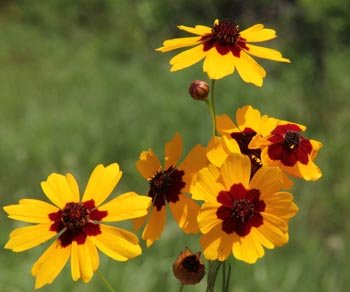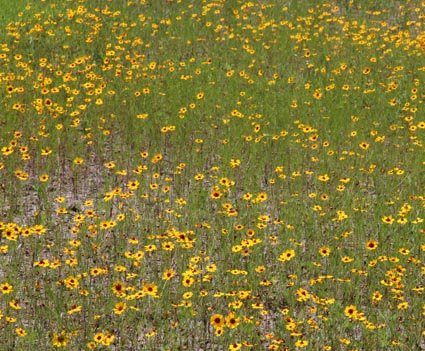





This little North American native is more than just a pretty face.
Coreopsis tinctoria is an airy little wildflower that graces the sunny meadows and roadsides every summer. Originally native to the eastern half of the continent, it has naturalized from coast to coast and all across Canada and Alaska. It is equally at home in cottage gardens and along roadsides. Known by a number of descriptive common names, tickseed, calliopsis, plains coreopsis, dyer's coreopsis and goldenwave, it is not only pretty but useful as well. One of its common names, 'tickseed' is a nod to its Latin designation. The word 'koris' means insect or bug and the suffix 'opsis' is a general designation meaning that the plant resembles the prefix. So core (koris) - opsis means that part of this plant (the seeds) resembles an insect. The Latin word, tinctoria means useful for dye.
 Native Americans boiled the flowers to make a type of beverage, the roots were steeped into a tea that eased the symptoms of diarrhea and abdominal discomforts. Folklore indicates that the tea was also supposed to protect the drinker from being hit by lightning. Early settlers also believed that stuffing their mattresses with the dried plants, it would repel bedbugs. The Zunni women believed that if they wanted a daughter, the tea would help conceive one as well. However, all of these uses were secondary to its main purpose. This sunny little flower produced a lovely yellow or red dye.
Native Americans boiled the flowers to make a type of beverage, the roots were steeped into a tea that eased the symptoms of diarrhea and abdominal discomforts. Folklore indicates that the tea was also supposed to protect the drinker from being hit by lightning. Early settlers also believed that stuffing their mattresses with the dried plants, it would repel bedbugs. The Zunni women believed that if they wanted a daughter, the tea would help conceive one as well. However, all of these uses were secondary to its main purpose. This sunny little flower produced a lovely yellow or red dye.
Now, the early peoples, simply steeped the flowers in heated water and added their yarn or fabric to the pot until it absorbed the color. This produced a product that was attractive but wasn't very colorfast. The dye tended to fade over time. Later experiments with different mordants resulted in more vibrant and colorfast items. Today's natural dyers might use any number of products to obtain various colors and shades from the same plant. For those just starting to explore natural dye, alum and vinegar are both easy to obtain and produce interesting results.
 Coreopsis tinctoria is a good choice for a beginner dyer's garden. It is an annual plant that reseeds with abundance. It is easy to grow, has few pests or diseases and deer tend to avoid it. This plant does double-duty as a nectar source for the bees and butterflies and small birds such as finches and sparrows like the seeds. Sow in full sun where the soil is well drained and moist. The plant can survive a bit of drought, but only once it is established. The image of the field in bloom was taken in my town near a spot that water often stands after a rain. While it drains after a day or so, it does remain moist most of the time. You'll get more blooms and a prolonged flowering season with ample moisture and shearing them back by half often produces a second flush of bloom. Depending on their location, Coreopsis tinctoria grows up to 3 feet (a meter) tall where it is happy. It is a great addition to any prairie, pollinator or cutting garden.
Coreopsis tinctoria is a good choice for a beginner dyer's garden. It is an annual plant that reseeds with abundance. It is easy to grow, has few pests or diseases and deer tend to avoid it. This plant does double-duty as a nectar source for the bees and butterflies and small birds such as finches and sparrows like the seeds. Sow in full sun where the soil is well drained and moist. The plant can survive a bit of drought, but only once it is established. The image of the field in bloom was taken in my town near a spot that water often stands after a rain. While it drains after a day or so, it does remain moist most of the time. You'll get more blooms and a prolonged flowering season with ample moisture and shearing them back by half often produces a second flush of bloom. Depending on their location, Coreopsis tinctoria grows up to 3 feet (a meter) tall where it is happy. It is a great addition to any prairie, pollinator or cutting garden.
Copyright © www.100flowers.win Botanic Garden All Rights Reserved